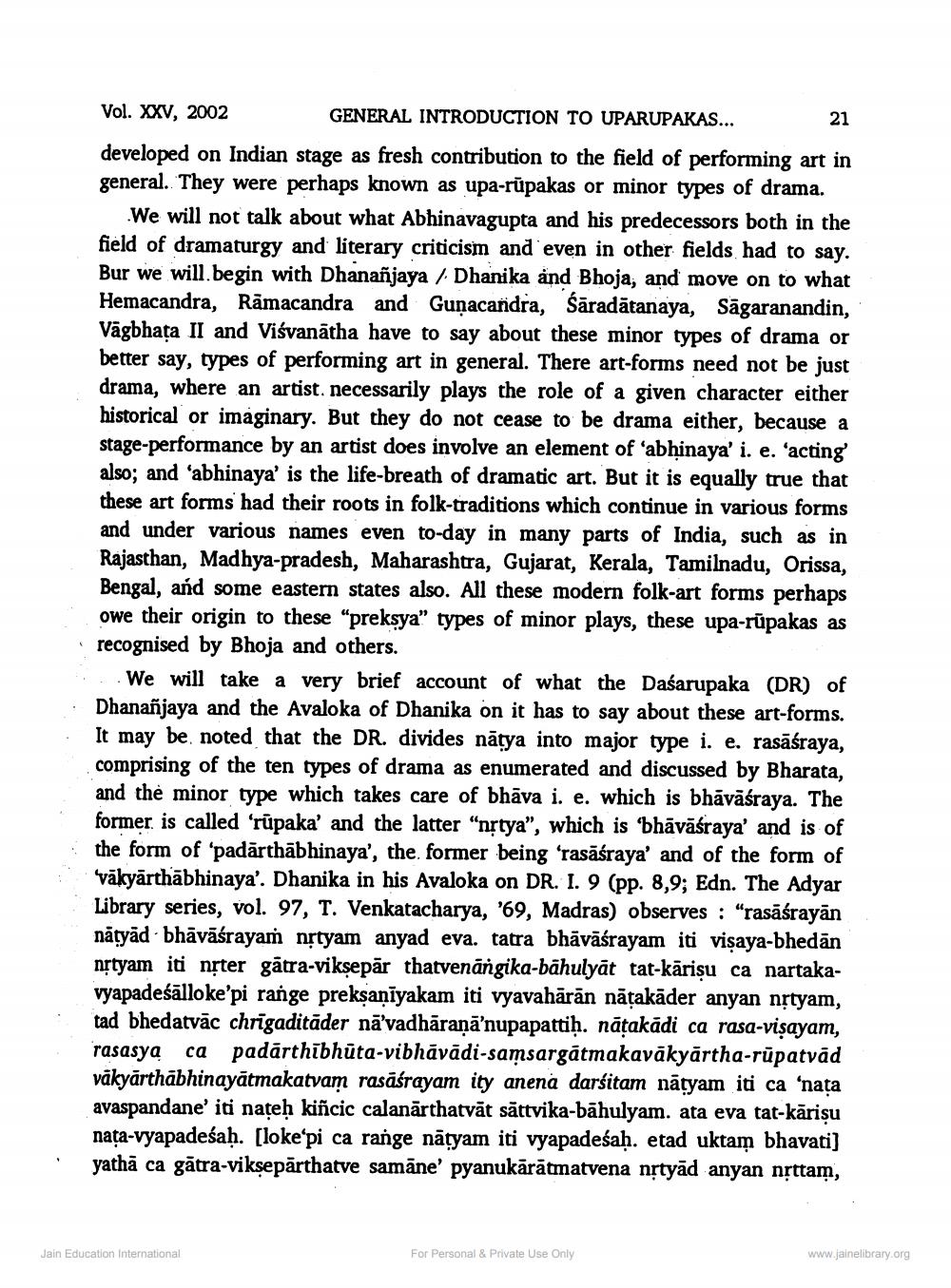________________
Vol. XXV, 2002
GENERAL INTRODUCTION TO UPARUPAKAS...
developed on Indian stage as fresh contribution to the field of performing art in general. They were perhaps known as upa-rupakas or minor types of drama.
We will not talk about what Abhinavagupta and his predecessors both in the field of dramaturgy and literary criticism and even in other fields had to say. Bur we will begin with Dhananjaya / Dhanika and Bhoja, and move on to what Hemacandra, Rāmacandra and Guṇacandra, Śāradātanaya, Sagaranandin, Vägbhața II and Viśvanatha have to say about these minor types of drama or better say, types of performing art in general. There art-forms need not be just drama, where an artist. necessarily plays the role of a given character either historical or imaginary. But they do not cease to be drama either, because a stage-performance by an artist does involve an element of 'abhinaya' i. e. 'acting' also; and 'abhinaya' is the life-breath of dramatic art. But it is equally true that these art forms had their roots in folk-traditions which continue in various forms and under various names even to-day in many parts of India, such as in Rajasthan, Madhya-pradesh, Maharashtra, Gujarat, Kerala, Tamilnadu, Orissa, Bengal, and some eastern states also. All these modern folk-art forms perhaps owe their origin to these "preksya" types of minor plays, these upa-rupakas as recognised by Bhoja and others.
21
We will take a very brief account of what the Daśarupaka (DR) of Dhananjaya and the Avaloka of Dhanika on it has to say about these art-forms. It may be noted that the DR. divides natya into major type i. e. rasāśraya, comprising of the ten types of drama as enumerated and discussed by Bharata, and the minor type which takes care of bhava i. e. which is bhāvāśraya. The former is called 'rupaka' and the latter "nṛtya", which is 'bhāvāśraya' and is of the form of 'padarthābhinaya', the former being 'rasasraya' and of the form of 'vākyarthābhinaya'. Dhanika in his Avaloka on DR. I. 9 (pp. 8,9; Edn. The Adyar Library series, vol. 97, T. Venkatacharya, '69, Madras) observes: "rasāśrayān nätyād bhāvāśrayam nṛtyam anyad eva. tatra bhāvāśrayam iti viṣaya-bhedān nṛtyam iti nṛter gatra-vikṣepār thatvenāngika-bahulyat tat-kāriṣu ca nartakavyapadeśalloke'pi range prekṣaṇīyakam iti vyavahārān nāṭakāder anyan nṛtyam, tad bhedatvāc chrīgaditāder na'vadhāraṇā'nupapattiḥ. nāṭakādi ca rasa-viṣayam, rasasya ca padarthibhūta-vibhāvādi-samsargātmakavākyārtha-rūpatvād vākyārthābhinayātmakatvam rasāśrayam ity anena darsitam natyam iti ca 'nata avaspandane' iti nateḥ kiñcic calanärthatvät sättvika-bāhulyam. ata eva tat-kāriṣu nata-vyapadeśaḥ. [loke'pi ca range natyam iti vyapadeśaḥ. etad uktam bhavati] yatha ca gatra-vikṣepārthatve samāne' pyanukārātmatvena nṛtyād anyan nṛttam,
Jain Education International
For Personal & Private Use Only
www.jainelibrary.org




